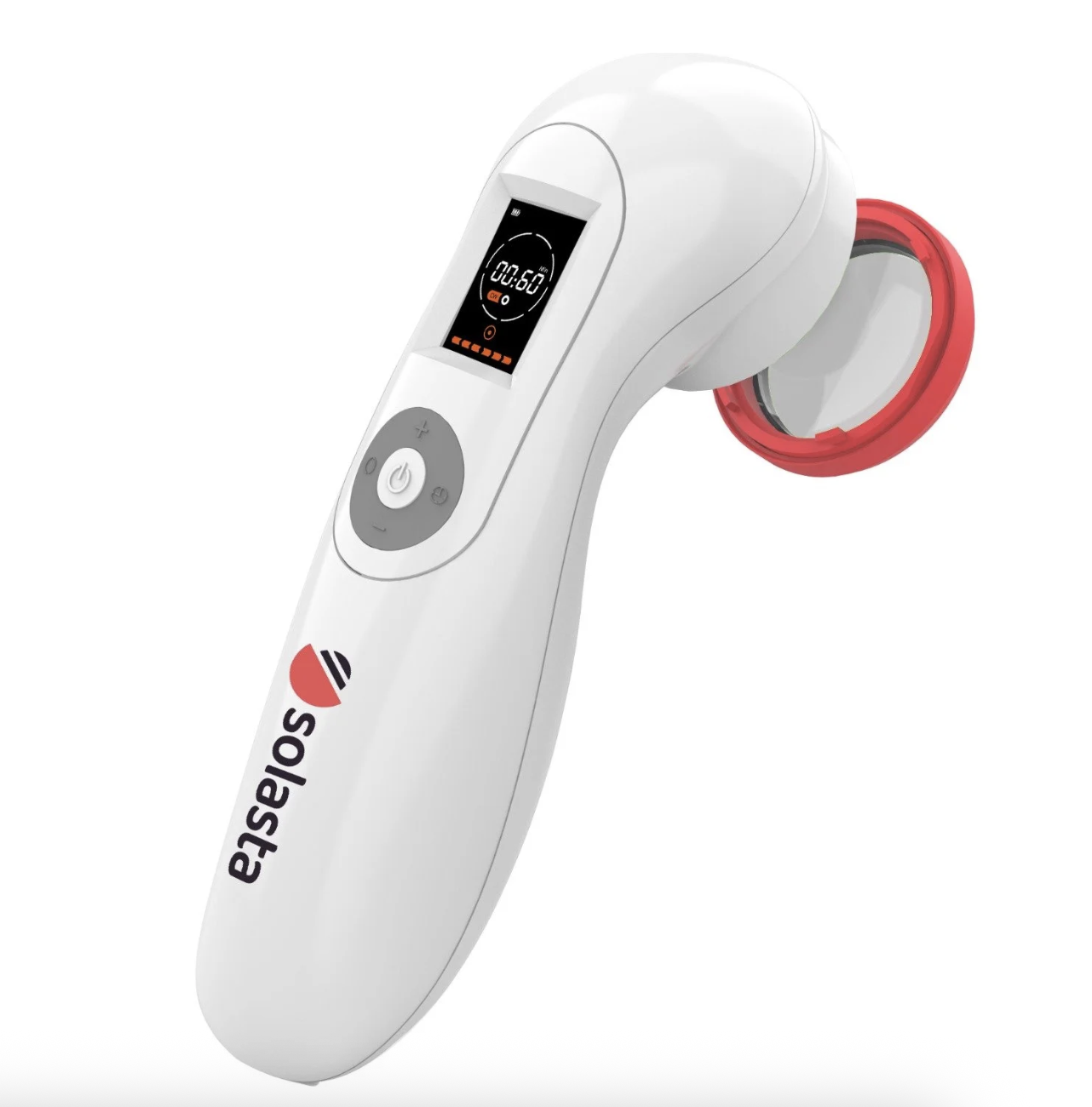The Complete Dog Owner’s Guide to Red Light Therapy, Photobiomodulation and Therapeutic Laser
What You Need to Know
(Especially if you're searching for laser therapy for dogs in Central Texas).
Let me introduce you to our two in-house test subjects - Samantha and Dexter.
Samantha (or Sam, if you're family) is our 14-year-old Irish Terrier with a red coat that's slowly giving way to grey. She had eye surgery last year and still rules the house with that same, scrappy energy but now it’s pirate style. Her partner in crime is Dexter, our 4-year-old French Bulldog, is equal parts snorty charm and orthopedic and allergy chaos - tight hips, skin flare-ups, and a tendency to overdramatize minor inconveniences.
Our fur babies Sam and Dexter
We started using laser therapy on them because, well... we already treat humans every day. Our practice has been helping clients with pain, inflammation, fertility, and injury recovery using Class IV laser.
But then something happened.
Clients started asking:
“Do you think this could help my dog’s arthritis?”
“My pup just had surgery - could I bring her in for laser too?”
And we realized something: our furry family members were being left out of the healing equation.
Now, we’re supporting both our two-legged and four-legged clients, and the results speak for themselves (dogs are treated in our home office in Round Rock not our laser clinic).
What Is Laser Therapy for Dogs?
Laser therapy, also known as photobiomodulation (PBM), uses targeted wavelengths of light (usually between 635 and 1064 nm) to stimulate healing at the cellular level.
No, it doesn’t burn or cut. It simply encourages the body to:
Increase circulation
Reduce inflammation
Boost energy (ATP) production in cells to accelerate recovery for neurons (nerves) bones and collagen.
Repair damaged tissue
It's like flipping the "healing switch" back on, without the meds, side effects, or long recovery times.
If you’re new to light therapy - this article is a great place to learn about HOW it works - the mechanism is impressive and is changing medicine in so many ways.
Why The Type of Device Matters
There are two main types of therapeutic lasers, and knowing the difference is crucial - especially if you're searching for dog laser therapy in the Austin/Round Rock area.
Class III (Cold/Low-Level Laser)
Power: Under 500 mW
Best for: Superficial wounds, minor inflammation
Used by: Most general vet clinics
Limitations: Takes longer to see results, can't reach deeper joints or spine
Class IV (High-Power Laser)
Power: Above 500 mW
Best for: Arthritis, hip dysplasia, IVDD, tendon injuries, and chronic joint pain
Used by us!
Benefits: Faster results, deeper penetration, stronger anti-inflammatory effects
In fact, multiple peer-reviewed studies show that Class IV lasers provide faster and more lasting relief than medication alone- especially in dogs with osteoarthritis or post-surgical recovery needs (Alves et al., 2022).
Why Wavelength Matters More Than You Think
One of the most important, and most overlooked factors in photobiomodulation is wavelength. It’s not just about shining any light on your dog and hoping for the best. The wavelength determines how deeply the light can penetrate, how safely it travels through the body, and whether it reaches the actual site of pain or injury.
Here’s what’s happening behind the scenes:
Shorter wavelengths (like 600 - 800 nm) are easily absorbed by the skin and fur, especially if your dog has a dark or thick coat. That means the energy can’t get past the surface - it gets “used up” before it can help the joint, muscle, or nerve underneath.
Very long wavelengths (like 980 nm and above) penetrate deeply but are absorbed quickly by water in the body, which can cause unwanted heating of the tissue and discomfort - without actually reaching the damaged area. Imagine warming up the skin but not helping the joint below. That’s not healing, that’s wasted energy (and possibly a squirmy dog).
This is why we don’t just pick a wavelength - we customize it based on the available evidence. This ensures safe and effective energy delivery whether your pup is jet-black, golden, or ginger like Sam.
In our sessions, we carefully blend wavelengths based on:
Your dog’s coat color and thickness
The depth of the tissue we need to reach
Whether we’re targeting inflammation, nerve pain, or wound healing
The goal is simple: Deliver just the right light, at just the right depth, with zero waste and maximum effect.
Why We Include 1064 nm in Our Doggy Protocols at Our Clinic
If you’ve ever wondered why we chose 1064 nm as a core part of our laser therapy protocol, here’s why:
1064 nm is one of the most effective wavelengths for deep tissue healing.
Unlike shorter wavelengths (600 - 800 nm), which get absorbed by melanin and fur, or the 900s which is heavily absorbed by water (causing surface heating), 1064 nm travels deeper into the body without being absorbed prematurely.
Here’s why it matters:
It bypasses the fur barrier - making it ideal for thick-coated or dark-colored dogs
It penetrates deep tissues like joints, spinal segments, and muscles where arthritis, disc disease, or inflammation live
It avoids excessive heating - because it’s not absorbed as strongly by water, it delivers therapeutic energy without discomfort
And when your dog is in pain, the last thing you want is a treatment that just warms the skin - or worse, causes agitation. With 1064 nm, we’re able to target the exact tissue that needs help, with powerful, focused, and safe results.
That’s why 1064 nm is being investigated in human sports medicine and orthopedic clinics - and we’re proud to bring that same level of care to our four-legged clients.
What Conditions Can Photobiomodulation Help With?
Laser therapy is incredibly versatile for humans and animals. It can help with:
Arthritis and joint pain, back pain and disc disease, post-surgical recovery, soft tissue injuries, skin wounds and more.
(Below are some old but still relevant videos of vets and owners sharing their experiences of a specific branded laser).
I Have a Red Light Device at Home
We hear this question a lot: “I already have a red light panel at home - can I just use that on my dog?”
Red light panels can be helpful for surface-level concerns like minor skin irritation or post-op incision healing. But when it comes to deep tissue issues - like arthritis, hip dysplasia, back pain, neurological issues or joint inflammation, most home-use panels just don’t deliver the power or depth needed to reach the actual problem areas.
Panels are designed for human skin exposure. They usually lack:
The penetrating wavelengths for fur (in the 900 - 1064 nm range)
The focused energy delivery (irradiance) needed to get through fur, fat, and muscle
And when your pup is in pain? You don’t want to waste precious time hoping a low-powered panel will do the job. You want something that works - and works fast especially if your dog can’t tolerate traditional pain meds.
That’s why we use Class IV lasers, blending the wavelengths based on your dog’s coat and condition. It’s safe, effective, and built specifically for the kind of healing our furry friends need most.
Whether your pup is recovering from surgery, managing arthritis, or just slowing down with age - laser therapy is a powerful, gentle, and proven way to support healing and reduce pain.
If you’re in the Austin area, know this:
➡️ Most vet clinics use low powered cold lasers (Class III).
➡️ For chronic pain, arthritis, back issues, or anything deep-tissue? Class IV is where the science - and the real results - live.
We’d love to help your dog feel their best again. Book a session, ask questions, or come meet Sam and Dexter yourself.
Can’t I Just Shave My Dog and Use Other Wavelengths Like 808 nm?”
808 nm is considered a deep-penetrating wavelength, and in many studies, it has shown excellent results for musculoskeletal conditions, including in veterinary applications. In fact, 808 nm is one of the most commonly used therapeutic wavelengths worldwide.
Shaving your dog’s fur can definitely help reduce light scattering and improve delivery of energy to the tissue. So if you’re using a laser with 808 nm and your dog’s coat is dark or thick, removing that fur can help ensure the light reaches further (especially if it’s a small area).
But here’s the nuance:
808 nm is absorbed by melanin (the pigment that gives us our skin color) - which means in dogs with dark skin or dark fur, you’ll still lose some energy near the surface.
It's also more absorbed by water than 1064 nm, which can lead to mild surface heating at higher power settings.
So while 808 nm is definitely capable of penetrating deeply, and is highly effective in many clinical cases - it’s not always the best choice for every dog, especially those with:
Thick fur and dark pigmentation
Spinal or neurological issues that require precise, deep tissue targeting
Sensitivity to heating, or inflammation near the surface
So yes, you can shave your dog and see good results with 808 nm. But for deep, chronic, or nerve-based issues, wavelength still matters, and longer wavelengths offer added advantages in terms of consistency and safety, especially when fur and pigment are part of the picture.
A Note for Fellow Frenchie Owners…
As many Frenchie parents know all too well, IVDD (intervertebral disc disease) can show up without warning - and when it does, the options are often bleak. Expensive surgery, long recovery, heartbreaking outcomes.
That’s one of the reasons we’re so passionate about laser therapy for dogs like Dexter. With regular sessions, we’re not only addressing day-to-day stiffness and inflammation - we’re supporting his spine proactively, giving him the best chance at resilience if IVDD ever decides to knock.
Because for breeds like Frenchies, waiting until something goes wrong just isn’t an option.
Understanding Myelomalacia - and How PBM May Help
One of the most devastating complications of spinal cord injury - particularly in severe cases of IVDD - is something called myelomalacia.
Myelomalacia is a rare but fatal condition where the spinal cord begins to soften and deteriorate after trauma, often following a disc rupture. It typically progresses rapidly, moving up or down the spinal cord, and sadly, there is no cure once it begins.
Signs may include:
Sudden loss of reflexes
Loss of pain perception
Flaccid paralysis
Difficulty breathing (if the disease ascends high enough)
For Frenchie owners and other high-risk breeds, just hearing the word myelomalacia is enough to make your heart drop. It’s every dog parent’s worst nightmare.
While PBM cannot reverse or cure myelomalacia, early intervention with therapeutic laser may offer protective, anti-inflammatory, and neuro-supportive effects when used at the very first signs of spinal distress.
Research shows that PBM:
Reduces oxidative stress and inflammation in spinal tissue
Improves mitochondrial function, helping cells resist further injury
Modulates immune response, which could potentially slow damaging inflammatory cascades
Supports glial and nerve cell survival in early injury phases
In other words, PBM may help protect vulnerable spinal cord tissue before things escalate.
While more studies are needed, especially in the context of myelomalacia, some veterinary neurologists are beginning to integrate PBM as an early adjunct therapy when IVDD is suspected, in hopes of improving outcomes or slowing progression.
We don’t have research on myelomalacia and red light therapy but do we know the mechanism of photobiomodulation is likely to be helpful.
“It’s not a miracle - but it might buy you time.
And when every hour matters, that time can mean everything.”
What to Expect During a Canine Laser Therapy Session
Laser therapy for dogs is gentle, pain-free, and designed to keep your pet comfortable from start to finish. Here’s a step-by-step look at what happens during a typical session, based on evidence from clinical studies and veterinary practice guidelines:
Session Details: The laser device is moved slowly over the targeted area, with the handpiece in light contact or just above the fur/skin. Your dog and anyone in the room will wear special safety glasses during the treatment.
Duration: Most sessions last between 3 - 10 minutes, depending on the area being treated and your dog’s size.
Sensations: Dogs may feel a gentle warmth but should not experience pain or distress. Many dogs relax, some even nap during treatment!
Activity: No sedation is required. Most dogs can be held, or simply lie calmly for their session.
Aftercare: There are usually no special post-session requirements; your dog can return to daily activities immediately as advised by your vet.
Tip: Bring a treat or toy to help your dog feel comfortable, especially for first visits.
When Will You See Results?
Class IV laser therapy is used for a range of canine conditions, and the response depends on your dog’s specific health needs. Here’s what the science says about what you can expect:
Acute Injuries or Surgery: Owners often report reduced swelling and improved comfort within 1–3 sessions.
Chronic Joint Pain or Arthritis: Noticeable improvement may take 5 - 8 sessions, though some dogs show greater comfort and mobility after just a few treatments.
Maintenance and Prevention: For long-term conditions, sessions may transition to a maintenance schedule (e.g., once a week or every other week) as guided by your Vet and laser practitioner.
How long does it last?
Most dogs experience lasting relief between sessions, especially when laser therapy is part of a broader pain management or rehabilitation plan.
Is Laser Therapy Right for Every Dog?
Laser therapy is extremely safe when performed by trained professionals and guided by veterinary assessment. There are, however, certain situations where extra caution is required:
Contraindications:
Avoid laser therapy over malignant tumors.
Not recommended for use on the abdomen of pregnant animals.
Never applied directly over the eyes; everyone in the room wears special safety goggles.
Caution with sites of active bleeding.
Screening and Consultation:
Your provider should review your dog’s medical history and consult with your veterinarian if complex conditions are present.
PBM is often best used alongside, not instead of, other necessary medical treatments. Laser therapy is an adjunct, not a replacement for veterinary diagnosis and care, always inform your primary vet when starting new therapies.
If your veterinarian doesn’t offer Class IV laser therapy, it’s often about practicality, not a lack of caring or up-to-date knowledge on your pet’s condition. Sometimes, clinics choose to start with lower-powered devices to serve the widest range of cases at a lower cost. Some veterinarians believe cold/low-level and Class IV lasers do the same thing especially for superficial conditions like wounds or minor inflammation. Veterinary training and early continuing education have often focused on low-level laser use, which also shapes these beliefs.
Thinking About Buying a Handheld Laser or Red Light Pad for Your Dog?
If you’ve been researching options to help your dog feel better, after surgery, injury, or a chronic condition like arthritis you’ve probably stumbled on a sea of red light therapy devices. Handheld lasers, wearable pads, red light panels, it’s a lot to sort through.
Another common question we hear is:
“Can I just buy one of these devices online and use it at home?”
The short answer is yes - in some cases, at-home devices can be helpful. But there are a few key things you’ll want to consider before you invest.
What These Devices Can Actually Do
Handheld lasers and red light therapy pads can support healing, reduce inflammation, and relieve mild to moderate pain, especially when used for things like post-op recovery, muscle strain, or early arthritis. We’ve seen some great results with high-quality at-home tools, especially when they’re used consistently and with the right guidance.
But when it comes to deeper issues like disc disease, severe joint pain, or nerve involvement, many at-home devices just don’t have the power or penetration to reach the tissue that truly needs support - but our new Solasta home laser does. It’s one of the most affordable and most powerful home lasers available in the US with 1300 mW/cm2. It works on humans and our furry friends too to manage pain.
Wavelength and Power - Not Just Buzzwords
For light therapy to work, the light needs to reach the target tissue. That’s where wavelength comes in.
Look for devices that offer infrared wavelengths - typically between 808 nm and 1064 nm - which can penetrate deep enough to impact joints, nerves, and muscles.
Then there’s power. Low-power devices (under 500 mW) may feel warm and relaxing but aren’t likely to deliver enough energy to the deeper layers of tissue. If your dog has thick fur, a heavier build, or a deep-seated issue, power becomes even more important.
What About Red Light Pads?
Red light therapy pads are a popular choice for a reason, they’re easy to use, they can cover large areas (like the hips or back), and they’re usually more comfortable for wiggly pups than a handheld device.
But again, the wavelengths and power levels matter. Many pads are underpowered or only emit red light, not infrared. And that means they’ll only be helpful for surface-level support unless specifically designed for deeper tissue penetration.
If you're investing in a pad, choose one that includes infrared wavelengths (not just red), and ideally one with adjustable settings or pulsing options.
Also, think about hygiene - especially if you’ll be sharing the pad with another pet or using it for yourself too. Look for pads with a wipeable plastic cover, or cover the surface with a layer of saran wrap before each session. It’s a simple step that makes a big difference, especially for post-op wounds or sensitive skin.
If you don’t have access to Class IV laser therapy at a vet clinic - or you want to support your dog between professional treatments, a high-quality handheld laser or infrared pad can absolutely help. We’ve tested several options over the years and only recommend a select few through our affiliate program, devices we trust, use on our own dogs, and feel confident suggesting to clients.
If you’re not sure where to start, or whether your dog’s condition can be supported with an at-home tool, feel free to reach out. We’re happy to help you make a decision based on what’s safe, science-backed, and actually worth your time.
Our Red Light Recommended Products - for Humans and Pets
Why We Now Offer Laser Therapy for Dogs at Our Clinic
We’ve been in your shoes. We’ve felt that sinking feeling when your pup is distressed and nothing seems to help. We’ve driven for hours, back and forth to eye specialists in San Antonio with Sam because it was going to take weeks to get her a referral to an Austin doggy opthamologist. So when the vet says “wait and see,” and the medications don’t seem to touch the discomfort, you’re left wondering if this is just how things are going to be now.
It’s heartbreaking and exhausting.
We know that feeling. That I’ll do anything to help them moment.
That’s why we are now offering therapeutic laser sessions for dogs. We’ve seen how much it’s helped our own pups, and after hearing story after story from our human clients about their struggling dogs, it became crystal clear: our furry family members deserve this care too.
Our goal is simple:
To give dog parents a gentle, science-backed option.
To create space for hope where there hasn’t been much.
And to support both pets and their people with compassion, clarity, and care.
Because when your dog is hurting, it’s not “just a dog.”
It’s your heart on four legs.
And they deserve every chance to feel better too.
Tracy and Phil
Resources:
https://avmajournals.avma.org/view/journals/ajvr/83/8/ajvr.22.03.0036.xml (Double-blinded RCT - canine)
https://pmc.ncbi.nlm.nih.gov/articles/PMC6091142/ (RCT - blind placebo-controlled trial investigating the effects of photobiomodulation therapy (PBMT) on canine elbow osteoarthritis)
https://www.sciencedirect.com/science/article/abs/pii/S1938973618300011 (Systematic Review)
https://www.veterinary-practice.com/article/photobiomodulation-therapy-and-veterinary-first-aid
https://journals.sbmu.ac.ir/jlms/article/view/34763
https://ivcjournal.com/photobiomodulation-for-neurological-disorders-in-canines/
https://www.mdpi.com/2304-6732/11/7/632











